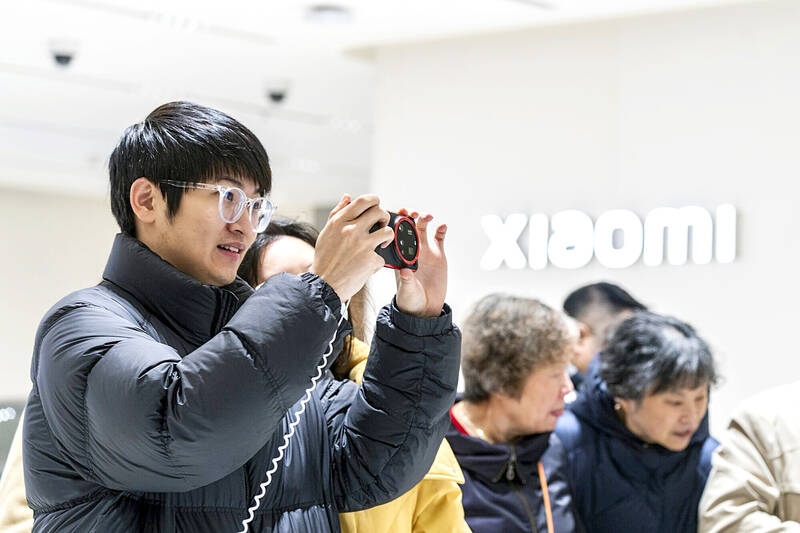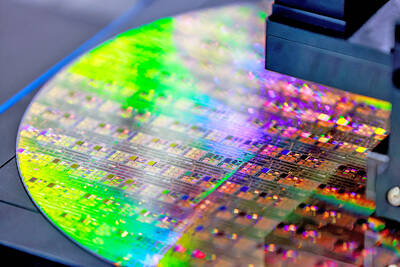Xiaomi Corp’s (小米) founder yesterday outlined plans to outfit the firm’s top-end devices with advanced homegrown mobile processors, showcasing the company’s ambitions to expand its tech portfolio and compete with US heavyweights.
Lei Jun (雷軍), who shot to fame with bold plans to unseat Apple Inc in China, gave online viewers a sneak peek at its Xring O1 chip, which he said would power three devices, including the Xiaomi Tablet 7 Ultra, another product launched at the same event, livestreamed from Beijing.
At 3 nanometers, the processor is aimed at matching Apple and Qualcomm Inc chips.

Photo: Bloomberg
“We also want to become one of the top chipmakers, with our phones targeting iPhones, can our chips also be compared against those of Apple’s?” he said.
Lei said that the Xring lags Apple’s own chipset in some respects such as processor speed, but added that it was an achievement for the Chinese company’s fledgling design team.
The entrepreneur, who often hosts product launches, was expected to trot out Xiaomi’s first electric sport utility vehicle (SUV) — the YU7 — at the same event.
Xiaomi is keen to push deeper into tech arenas beyond the affordable smartphones and appliances it is best known for.
Lei yesterday announced plans to invest 200 billion yuan (US$27.8 billion) in research and development over the next five years.
It wants to move past a fatal March incident involving one of its signature SU7 sedans that sent orders plunging the following month.
Xiaomi had raised its delivery target for electric vehicles (EV) this year to 350,000 units days before that incident, which prompted scrutiny over Xiaomi’s self-driving advertising claims.
It stoked concerns that the YU7 would be delayed.
Lei’s most important project is EVs — a US$10 billion attempt to take on Tesla Inc and BYD Co (比亞迪) that the founder has called his final endeavor as an entrepreneur.
The market for SUVs was more intense than that for sedans, Lei wrote on social media, but he believed that the YU7 has its own unique qualities.
It would not officially hit the market until at least July, with no pricing released at the event yesterday.
Xiaomi would not take pre-orders for the vehicle yet, Lei wrote in a separate social media post.
The company has also announced a US$7 billion investment to develop and enhance its own mobile processor over the next decade.
Xiaomi’s goals mirror Huawei Technologies Co’s (華為) breakthrough a few years ago, which spooked Washington and raised concerns about Chinese advances in strategic technologies such as artificial intelligence (AI) and chips.
Among the hard-tech initiatives it has touted since the March incident was an in-house large language model dubbed MiMo.
Executives have reportedly talked about investing in AI, although MiMo is the first real product to emerge.
Its foray marks the second big project in as many years for a company best-known for making affordable smartphones and appliances from robot vacuums to rice cookers.

Taiwan’s rapidly aging population is fueling a sharp increase in homes occupied solely by elderly people, a trend that is reshaping the nation’s housing market and social fabric, real-estate brokers said yesterday. About 850,000 residences were occupied by elderly people in the first quarter, including 655,000 that housed only one resident, the Ministry of the Interior said. The figures have nearly doubled from a decade earlier, Great Home Realty Co (大家房屋) said, as people aged 65 and older now make up 20.8 percent of the population. “The so-called silver tsunami represents more than just a demographic shift — it could fundamentally redefine the

The US government on Wednesday sanctioned more than two dozen companies in China, Turkey and the United Arab Emirates, including offshoots of a US chip firm, accusing the businesses of providing illicit support to Iran’s military or proxies. The US Department of Commerce included two subsidiaries of US-based chip distributor Arrow Electronics Inc (艾睿電子) on its so-called entity list published on the federal register for facilitating purchases by Iran’s proxies of US tech. Arrow spokesman John Hourigan said that the subsidiaries have been operating in full compliance with US export control regulations and his company is discussing with the US Bureau of

Businesses across the global semiconductor supply chain are bracing themselves for disruptions from an escalating trade war, after China imposed curbs on rare earth mineral exports and the US responded with additional tariffs and restrictions on software sales to the Asian nation. China’s restrictions, the most targeted move yet to limit supplies of rare earth materials, represent the first major attempt by Beijing to exercise long-arm jurisdiction over foreign companies to target the semiconductor industry, threatening to stall the chips powering the artificial intelligence (AI) boom. They prompted US President Donald Trump on Friday to announce that he would impose an additional

China Airlines Ltd (CAL, 中華航空) said it expects peak season effects in the fourth quarter to continue to boost demand for passenger flights and cargo services, after reporting its second-highest-ever September sales on Monday. The carrier said it posted NT$15.88 billion (US$517 million) in consolidated sales last month, trailing only September last year’s NT$16.01 billion. Last month, CAL generated NT$8.77 billion from its passenger flights and NT$5.37 billion from cargo services, it said. In the first nine months of this year, the carrier posted NT$154.93 billion in cumulative sales, up 2.62 percent from a year earlier, marking the second-highest level for the January-September